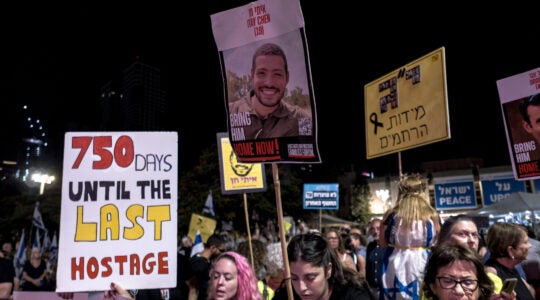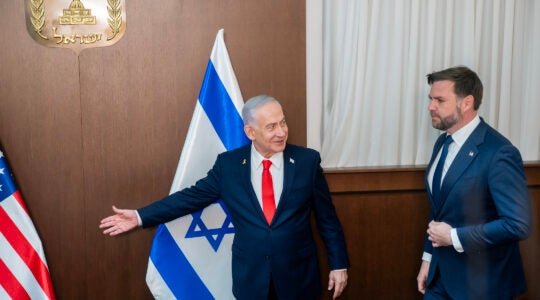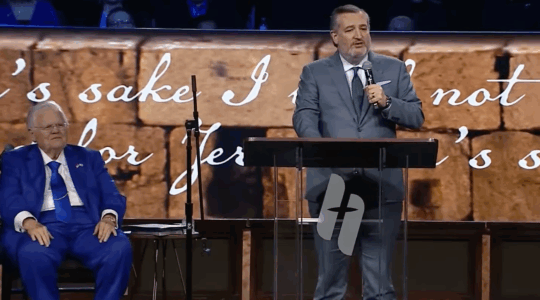WASHINGTON (JTA) — This time there are maps — not that they necessarily will help.
After the collapse of the Camp David talks in 2000, the Israeli and Palestinian sides bickered about who had offered what, and the competing historical narratives were adopted by either side and around the world.
This time, the proposed territorial concessions that former Israeli Prime Minister Ehud Olmert and Palestinian negotiators discussed are visible in living color — in a set of leaked Palestinian Authority documents published by Al Jazeera.
The maps are significant because they show how close the two sides are on some issues — for example, which would control certain Jewish neighborhoods in eastern Jerusalem. But they also show that the gaps on other issues remain far from resolution, particularly regarding Jewish settlements deep inside the West Bank.
Back in 2000, Dennis Ross, now the lead negotiator on the issue, talked President Clinton into not committing anything to paper because he said the controversy that would ensue from maps and percentage sheets outweighed the value of getting things down in writing. He especially distrusted the late Palestinian leader Yasser Arafat.
Instead of squelching controversy, however, the absence of written proposals and maps stoked it.
Now the leaked maps will help keep the Palestinian and Israeli positions straight.
The map detailing Olmert’s alleged offer to the Palestinian side shows Israel giving 5.5 percent of territory in Israel proper in exchange for 6.8 percent of the West Bank. The swaps that Ahmed Qureia, a former PA prime minister and a top negotiator, reportedly proposed in January 2008 to then-Israeli Foreign Minister Tzipi Livni were a 1:1 ratio and amounted to trading to Israel less than 2 percent of the West Bank.
The Palestinian Authority accounts of meetings with Israeli and American interlocutors reveal many areas of agreement, most of which have been known widely for years. The Palestinians want recognition of the rights of Palestinian refugees and their descendants from Israel’s 1948 War of Independence, but they also acknowledge that the refugees ultimately will remain where they are living now.
“If the Arabs will be part of the solution, there will be no problem in this issue,” Qureia told Livni in 2008. “We have to engage countries that host the refugees.”
Such compromises appear contingent on the relationship between Palestinian and Israeli leaders. Ties between the Palestinian Authority and the Olmert government in 2008 were better than they are now between the Palestinian Authority and Benjamin Netanyahu’s government. In 2008, direct negotiations were a matter of course, not an aspiration.
How mutual suspicion affects talks is made evident in the leaked report of an October 2009 meeting between George Mitchell, the top U.S. envoy to the region, and Saeb Erekat, the lead PA negotiator. Erekat says that if Netanyahu insists on rejecting refugee rights at the outset, the “Palestinian leadership can only respond by insisting on full exercise of right of return.”
The same dynamic, in which friendlier talks lead to more expansive proposals, applies to territory. In May 2008, in another meeting with Livni, Qureia apparently outlined a deal that would allow Israel to retain a chunk of Gush Etzion, the bloc of Jewish settlements south of Jerusalem, near Bethlehem, as well as nearly all of the Jewish neighborhoods in Jerusalem. In the October 2009 meeting with Mitchell, Erekat says construction in some of those neighborhoods is inhibiting talks.
The most striking theme that recurs in the documents is how far apart the parties are when it comes to balancing Israel’s reluctance to relocate settlers with Palestinian demands for territorial contiguity in the West Bank.
“In the end the whole matter isn’t merely the value of exchange but the reality of those Israelis and where they live,” Livni says in an exchange from the Jan. 27, 2008 meeting between Livni and Qureia in Jerusalem.
Qureia responds, referring to Maaleh Adumim and Givet Zeev, large West Bank Jewish settlements that serve as bedroom communities for Jerusalem, “I can’t accept Maaaleh Adumim settlement as a reality because it divides the West Bank, and the same goes for Givat Zeev settlement.”
If anything, the documents shatter the illusion that there is a bottom-line consensus about certain settlements being annexed to Israel in a final-status agreement. Many groups refer to these as the “everybody knows” settlements, such as Maaleh Edumim and Efrat, both near Jerusalem.
In fact, the gap is broader than expected, and helps explain why PA President Mahmoud Abbas turned down Olmert’s offer in mid-2008. Olmert refused to give Abbas the map, so Abbas scribbled it down on a paper, and it became known as a “napkin map,” which is what Al Jazeera published this week.
Another “everybody knows” myth shattered by the leaks is the notion that the Palestinians would accept as swaps Negev desert lands adjacent to the Gaza Strip. In the leaked documents, the Palestinians scoff at such swaps and want equally as arable land as the lands they would cede.
The Olmert map, in its attempt to maximize the amount of settlers Israel would retain, resembles a proposal advanced last week by David Makovksy, a senior fellow at the Washington Institute for Near East Policy, a leading pro-Israel think tank in Washington. Makovsky, who is close to Ross, says he has presented the map to officials in the Israeli, Palestinian and U.S. governments.
“The goal of ‘Imagining the Border’ is to present a menu of options for resolving the territorial component of the conflict, meeting Palestinian demands of minimal land swaps with a 1:1 ratio while allowing Israel to annex areas containing the majority of West Bank settlers,” Makovsky says.
Makovsky manages to narrow the gap between Olmert’s 6.8 percent and Qureia’s 1.9 percent to 3.7 percent, but he retains the “fingers” Olmert’s map thrust into the West Bank to capture large Israeli settlements. The Palestinians insist those are unacceptable.
Sticking points seem never-ending. The Palestinians regard Latrun, an area southwest of Jerusalem secured by Israel in one of the Independence War’s bloodiest battles, as “no man’s land” because of its designation as such on some maps. They regard its retention by Israel as a concession. Israel and the international community view it as Israeli territory.
Such nitpicking has a toll.
According to the documents, Livni starts the May 4, 2008 meeting at the King David Hotel in Jerusalem dryly: “Based on what I have heard in the trilateral meeting with Condoleeza Rice, I believe that your offer will not be exciting,” she tells Qureia, referring to the then-U.S. secretary of state.
The Palestinians are unrelenting in pleading with the Americans, in meeting after meeting, to press the Israelis to freeze settlement growth.
“Everyone is saying look at what they get from violence, etc.,” Qureia tells Rice in a July 16, 2008 meeting in Washington. “Please. We need your help on settlements” and on the removal of roadblocks and other Palestinians demands.
Settlements continue to dog the talks today.
The Palestinian posture now is not to return to direct talks until Israel reinstates a freeze on Jewish building in the West Bank. Palestinian allies are circulating a resolution in the U.N. Security Council that blasts Israel for settlement building and urges a return to talks. The Obama administration is opposed to the resolution but has not said whether or not it will veto it.
Occasionally, however, the leaked documents show a surprising concession emerges from talks that the sides thought were secret.
Livni, apparently warning the Palestinians not to make an issue of Israel’s Law of Return, tells Qureia and Erekat in January 2008 that “Israel was established to become a national home for Jews from all over the world. The Jew gets the citizenship as soon as he steps in Israel, and therefore don’t say anything about the nature of Israel, as I don’t wish to interfere in the nature of your state.”
That seems to undercut a policy that she introduced and that now haunts talks: That Palestinians need to recognize Israel as a Jewish state.
In the same exchange, Erekat also tosses aside the Palestinian doctrine that all Jewish settlers need to leave the West Bank.
“We don’t mind to have settlers live as Palestinian citizens who have all rights under the Palestinian law,” he says.
JTA has documented Jewish history in real-time for over a century. Keep our journalism strong by joining us in supporting independent, award-winning reporting.





